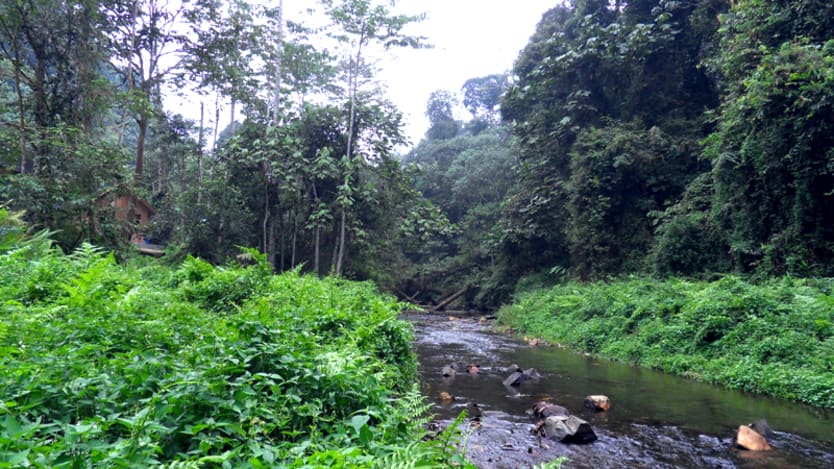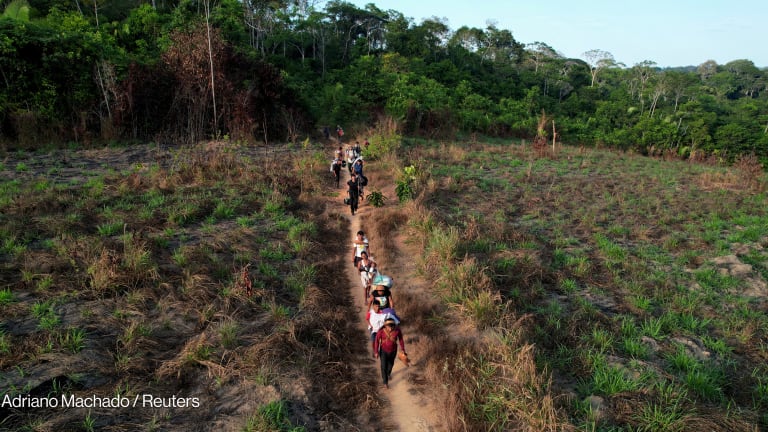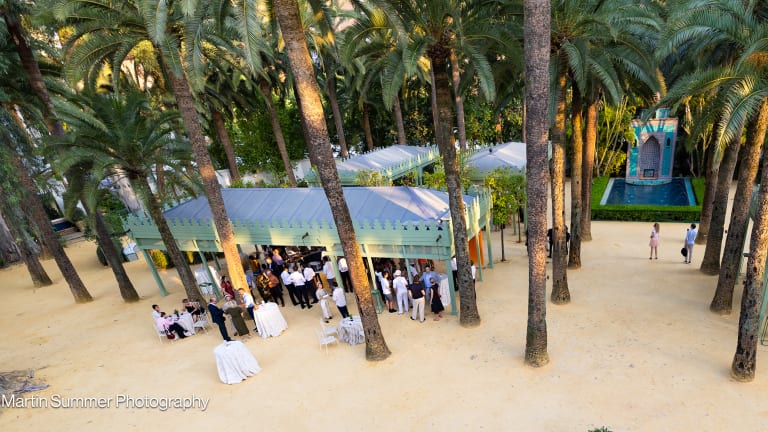
SAN FRANCISCO — Michelin, the tire manufacturer, is the world’s largest buyer of natural rubber. It was also the first tire maker to commit to responsible rubber sourcing. Together with the nature conservation organization World Wildlife Fund, the company has committed to achieving wildlife-friendly rubber in Asian forests that were previously cleared for rubber trees, and displaced tigers, orangutans, and elephants in the process. One example of the collaboration between Michelin and WWF is a project called Thirty Hills, on the east coast of Sumatra, Indonesia, an island that has become a deforestation hotspot.
“These are not one-off projects,” said Paul Chatterton, founder and lead of WWF’s Landscape Finance Lab, at a meeting Devex joined in June where stakeholders gathered to learn more about this incubator for blended finance landscape regeneration projects. “This potentially can be a system where the whole world can be managed in a much more sophisticated and integrated way to protect biodiversity and benefit human beings.”
On Tuesday, WWF and partners including Clarmondial, an investment advisory company focused on environmental businesses, and the Global Environment Facility, an international partnership to tackle environmental problems, launched Capitalising Conservation. The report explores how to mobilize private investment in conservation, providing conservation organizations and their partners with a framework for how to identify, structure, and execute investments.
“We need to find new avenues to protect and enhance natural capital in ways that are also profitable for investors,” Naoko Ishii, CEO of the Global Environment Facility, said in a press statement ahead of the launch. “This requires innovative investment strategies, delivery structures, and partnerships — and conservation organizations have a critical role to play.”
WWF commissioned the report, which was released during COP23, the United Nations climate conference in Bonn, Germany. It provides a window into why the organization is experimenting with a new way to bring innovative financing to its work across forest, freshwater, and coastal marine ecosystems.
WWF launched the Landscape Finance Lab last year to develop and finance sustainable landscapes in some of the most biodiverse regions of the world, capturing its work on its website as “incubating sustainable landscapes.”
In order to achieve the U.N. Sustainable Development Goals, the world needs landscapes that can meet its needs in the present, without compromising the options that future generations will have. WWF argues that this can only happen through integrated landscape management, or collaboration among multiple stakeholders to make landscapes sustainable. According to the Landscape Finance Lab team, the five key elements in achieving this are: bringing groups together in a multi-stakeholder platform; developing a shared understanding of the landscape conditions, challenges, and opportunities; collaborating on both the planning and implementation of a jointly agreed action plan; and monitoring, then adapting, and continuing the collaboration. The three catalysts that enable integrated landscape management, the group says, are good governance, market access, and sustainable finance.
In June, Chatterton traveled from his base in Austria to Silicon Valley in the U.S. for meetings with, among others, two venture design labs. The three-hour sessions were convened by David Hodgson, the founder of Hummingbird Labs, an innovation lab that has focused lately on the regenerative economy. He sees the Landscape Finance Lab as a way to help large multinationals make this transition by transforming their supply chains so that they benefit rather than diminish the planet, he said.
“This has the potential to create massive impact — from biological carbon sequestration, through poverty alleviation, to biodiversity conservation,” he wrote in May in an email invitation to leaders he hoped would join the workshop.
He explained that the lab was in a pivotal stage of development, with an initial portfolio of 20 projects under development that he was exploring with partners how to scale tenfold. One of the opportunities Chatterton emphasized was how landscape sourcing can benefit business, mentioning trial programs underway with companies including Michelin, fashion retailer H&M, and furniture company IKEA. The Capitalising Conservation report expands on why companies might see it in their business interest to pursue a landscape approach. It highlights in particular an interview about Nestlé Nespresso, which has a strategy called “The Positive Cup,” with the goal of every cup of coffee having a positive impact.
“I'm really excited about the potential for the lab to scale, especially if we can connect people to the resources, support, and communities working on similar things to take advantage of economies of scale,” said Deesha Chandra, who works with Chatterton to manage the online community for the Landscape Finance Lab.
She said external-facing sessions, such as the workshop in June, help the WWF team check some of their assumptions. They can also bring in new ways of thinking about their current challenges, ways to navigate them, and how to scale their work.
Not everyone in the room was totally on board with, or even clear about the goals of, the Landscape Finance Lab. Mike Korchinsky of Wildlife Works explained to the group that his organization works to develop economic solutions for communities “so they can afford to let wildlife live.” The lab follows a number of attempts at landscape finance initiatives, but what remains to be seen is how inclusive WWF will be in their implementation, he said, pointing to efforts by other groups such as the Belantara Foundation in Indonesia, the Center for International Forestry Research, and the U.N. Environment Programme Finance Initiative.
“In recent years, we’ve seen a huge shift away from traditional conservation that favored protecting nature for its intrinsic worth towards a more integrated approach centred on nature’s value to humanity,” Steven Rocliffe, research and learning manager at the social enterprise Blue Ventures, told Devex via email.
Implicit in this is recognition of two things, he said: that conservation isn’t just about conserving a few animals in a protected area, but rather about managing and working with people; and that we can and should put a price on nature.
“As conservation’s remit has expanded, so too have the ways in which it’s implemented and financed. Paying for conservation isn’t the sole preserve of government any longer. With methods that properly account for the value of natural assets in bottom line calculations continuing to improve, private investors are increasingly realising that saving ecosystems can be affordable and perhaps profitable. Added to this, social enterprises at the coal face of conservation are beginning to create a new wave of disruptive approaches to conservation, piquing interest from philanthropic foundations not usually associated with [it],” Rocliffe said.
Chatterton said the Landscape Finance Lab is working to form a movement to achieve 100 sustainable landscapes, which would capture the most threatened and poorest and richest in biodiversity, before broadening its focus to 1,000 sustainable landscapes. Meanwhile, the Capitalising Conservation report explores how other conservation organizations and their partners are mobilizing private investment in conservation. Chatterton likes to say he is building the plane as he flies — and that the team welcomes feedback to make sure they are flying in the right direction.
Read more Devex coverage on conservation.








